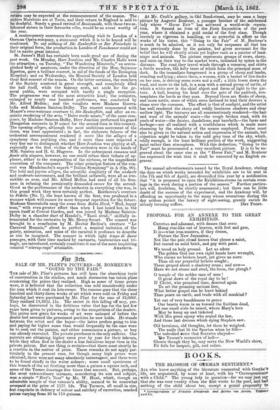fiat 3r10.
SALE OF MR. FLINT'S PICTURES—M. BONIIEUR'S "GOING TO THE FAIR."
Ttrz sale of Mr. Flint's pictures has still been the absorbing topic of conversation in the studios, and much discussion has taken place concerning the prices they realized. High as some of those prices were, it is believed that the collection was sold considerably under the sum which it cost its late owner. The rumour goes that the three hundred and thirty-Wee works of art which were sold on Friday and Saturday last were purchased by Mr. Phut for the awn of 25,000/. They realized 18,3911, 11s. The secret in this falling off may, per- haps, be discovered in the fictitious value that has for the last few 7ears been given to pictures, owing to the competition.of the dealers. Ihe prices now given for works of art were unheard of before the dealer had assumed the prominent position he now holds. He stands between the artist and the buyer—the latter prefers going to him and paying far higher sums than would frequently be the ease were he to seek out the painter, and either commission a picture, or buy one already executed. The private purchaser is the only sufferer. Our painters are obtaining higher sums year by year for their labours, while they often find in the dealer a less fastidious buyer than in the private patron. But one thing is certain—that there must shortly be a reaction in the matter of price. These remarks do not apply par- ticularly to the present case, for though many high prices were obtained, there were not many absolutely extravagant, and these were to be found chiefly in the water colours; some small specimens of this branch of the art fetching- more than a guinea a square inch, and some of the Turner drawings five times that amount. But, perhaps, the most extraordinary instance, considering its size and subject, was a simple "Bird's Nest" by Mr. W. Hunt, which, though an admirable sample of that veteran's ability, seemed to be somewhat overpaid at the price of 117/. 12s. The Turners, all small in size, but exquisite in delicacy of colour and subtlety of execution, reached prices varying from 50 to 110 guineas. picture by Auguste Bonheur, a younger brother of the celebrated lady whose Horse Fair" 'has achieved a world-wide reputa- tion. It formed an item of the Paris Exposition of the past year, where it obtained a gold medal of the first class. Though scarcely so vigorous in handling, or so powerful in effect as the works of his sister, this "Going to the Fair" of M. Bonheur's is much to be admired, as it not only far surpasses all that has been previously done by the painter, but gives covenant for the belief that he will shortly attain yet higher rank as a painter of land- scape and animals. The picture represents groups of cows, sheep, and oxen on their way to the market town, indicated by spires in the distance- The road they travel winds through a common, and skirts a fertile meadow, the lofty trees of which form the principal mass of dark. In the immediate foreground is a group of sheep and lambs, standing and lying; above them, a woman' with a basket of live ducks on her arm, is driving some cows and a calf; a little lower down the road, and more to the left, is a man with a second group of cattle, of which a white cow is the chief abject and focus of light to the pic- ture. A bull, leaning his head over the gate of the paddock, con- templates the herds as they pass. Beyond these are flocks of sheep, and more cattle, some of which seem inclined to lead their drovers a chase over the common. The effect is that of sunlight, and the artist has well rendered the sharp and coldly luminous shadows and clear mellow light. The textures are all conscientiously rendered—the hair and wool of the animals' coats—the rough broken road, with its pools of water—the daisies, dandelions, and harebells—the furze and herbage—are all realized with a truthfulness which is made more charming by the simplicity of the means employed. Praise must also be given to the natural action and expression of the animals, but objection might be taken to the cold grey tone of the sky, which, oddly enough, is the least brilliant portion of the work, suggesting t rather than atmosphere. With this deduction, "Going to the air" must be pronounced a very excellent picture. It is to be en- graved about the same size as the "Horse Fair," and M. Bonheur has expressed the wish that it shall be executed by an English en- graver.
The annual advertisements issued by the Royal Academy, stating the days on which works intended for exhibition are to he sent m (the 7th and 8th of April), are diversified this year by a notification that "it is proposed to open the Exhibition-rooms on certain even- ings in the week during a portion of the season." Further particu- lars will, doubtless, be shortly announced; but there can be little doubt of the success of the experiment, and the Academy will, by affording an opportunity to the many whose avocations during the day seldom permit the luxury of sight-seeing, greatly enrich. its






























 Previous page
Previous page